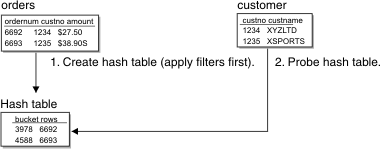Hash join
The optimizer usually uses a hash join when at least one of the two join tables does not have an index on the join column or when the database server must read a large number of rows from both tables. No index and no sorting is required when the database server performs a hash join.
A hash join consists of two activities: first building the hash table (build phase) and then probing the hash table (probe phase). How a hash join is executed shows the hash join in detail.
In the build phase, the database server reads one table and, after it applies any filters, creates a hash table. Think of a hash table conceptually as a series of buckets, each with an address that is derived from the key value by applying a hash function. The database server does not sort keys in a particular hash bucket.
Smaller hash tables can fit in the virtual portion of database server shared memory. The database server stores larger hash files on disk in the dbspace specified by the DBSPACETEMP configuration parameter or the DBSPACETEMP environment variable.
